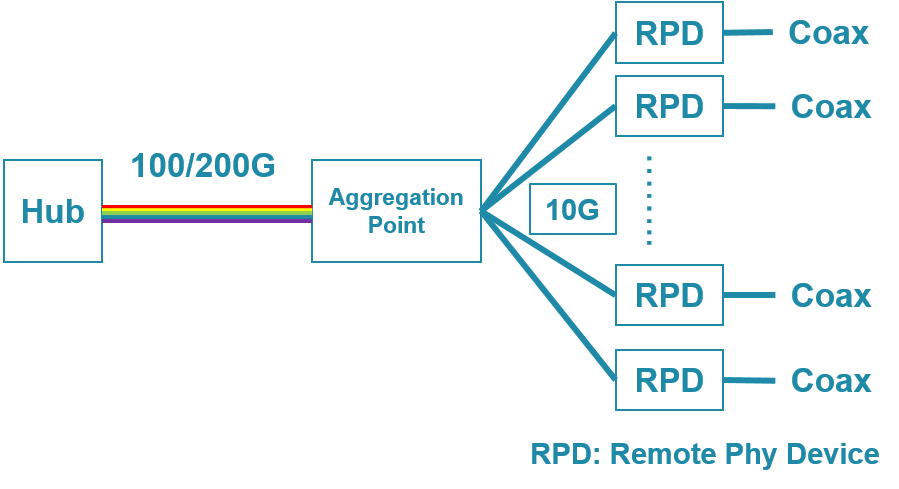Cable Tech is Hot This Month: Let’s Talk Coherent
By Lisa Crewe | Posted on October 8, 2020
Cable Tech is Hot This Month: Let’s Talk Coherent


October is a hot month for cable technology shows with both the SCTE Cable-Tec Expo and the Light Reading Cable Next-Gen Digital Symposium taking place. While both shows are virtual, we expect there will be some conversations around the emergence of coherent technology in the edge and access market. As Sterling Perrin, Sr. Principal Analyst at Heavy Reading commented in Acacia’s first edge and access product announcement, “Over the past decade, coherent technology has moved beyond its long-haul origins and is now firmly entrenched in the metro. With the coming of 5G and edge computing, the time is right for coherent optics to take the next step and migrate to edge and access networks.”
Meeting Growing Bandwidth Demand
Streaming services for residential entertainment have long been drivers for bandwidth demand over service provider access networks. Applications that go beyond streaming entertainment, such as uploading 4K-resolution videos into the cloud for social-network sharing and the increased use of two-way video chats and file sharing tied to work-from-home requirements, are driving the need for increased bandwidth, especially when traffic from a large number of end users is aggregated. The ability of the legacy optical service provider edge and access infrastructure to support this growing bandwidth demand is a challenge. That’s why cable network operators (a.k.a, multi-service operators, MSOs) currently utilizing 10G optical links are seeking to upgrade to 100G links that operate over edge and access fiber routes.

In fiber-constrained access environments, it’s not unusual to have data transmission over a single fiber strand carrying both downstream and upstream traffic —a.k.a, bi-directional (BiDi) traffic. Network operators upgrading their service provider edge/access bandwidth face the challenge of overcoming limitations due to legacy optical technology not capable of supporting data rates beyond a certain speed for a given distance, while at the same time supporting BiDi transmission.
The Migration of Coherent into Edge and Access
Meanwhile, much progress has been made over the past decade to reduce the size, power and cost of coherent solutions which has enabled its evolution from supporting long-haul to metro networks. More recently, requirements from data center network operators for high-capacity, high-density, solutions in pluggable form factors widely used for client-optics slots have driven industry-wide investments into ultra-compact, low-power and economical coherent solutions that can be manufactured in high volumes. This opens up new addressable markets for coherent solutions in edge and access networks including cable that can provide scalable and operationally flexible solutions to address growing bandwidth demands.
Cable Network Applications for Coherent
The cable industry has been driving standardization of coherent for access aggregation in this segment for quite some time. As the hybrid fiber-coax (HFC) networks evolve toward remote PHY architectures, fiber is being deployed deeper in the network, resulting in increased available bandwidth to residential end-user customers, while eliminating bottlenecks in the HFC network. 10G optical interfaces are pushed closer to the end users, resulting in aggregation points in the network where 10-20 remote PHY devices come together.

Remote PHY network
Acacia believes that coherent can be an effective way to transport these aggregated signals back to the hub. In some cases, it may only be necessary to transport a single coherent wavelength back to the hub, but since coherent solutions leverage dense wavelength division multiplexing (DWDM) technology, this approach could provide the capability to expand capacity by up to two orders of magnitude in the future.
As discussed above, in cable networks, particularly Remote PHY and fiber deep applications, providers often run into situations where only a single fiber is available. Historically, these networks have been served by 10G Bi-Di optical modules. To meet growing bandwidth demands, a coherent BiDi solution can provide these networks with an upgrade path to 100G and beyond. Also, in these situations where optical waves are transmitted in a single fiber medium from both directions, coherent receivers can efficiently help to eliminate the crosstalk from back reflections when it operates at a different wavelength than its transmitter.
Acacia’s Portfolio of Edge and Access Solutions
To serve the cable market, Acacia has developed solutions designed specifically for these applications.
- This week, Acacia announced that it was sampling a new 100G DWDM coherent pluggable solution. Offered in the QSFP-DD form factor, Acacia’s new 100G DWDM module was designed to provide a scalable traffic aggregation solution, as well as an upgrade path to migrate from existing 10G WDM networks to higher-performing 100G DWDM coherent links for new architectures in access networks, such as cable/fiber deep and 5G wireless X-haul applications.
- Also this week, Acacia announced the sampling of new coherent bi-directional pluggable optical module solutions designed to transmit and receive data in both directions on a single fiber for 100G and beyond. Offered in a pluggable CFP2-DCO form factor, Acacia’s coherent bi-directional module is designed to deliver an operationally efficient and cost-effective way for telecommunications and cable operators to increase capacity in fiber limited networks.
Let’s Talk About Cable and Coherent
If you want to learn more about how coherent is ready to help cable providers, click here to set up a meeting.



